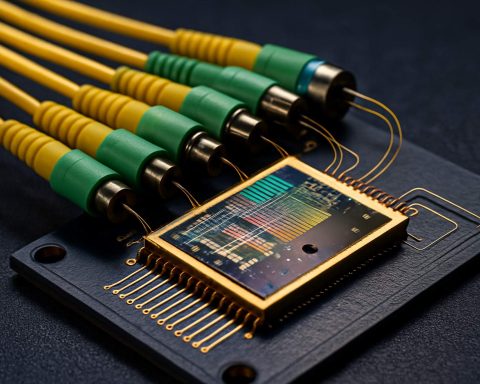- The semiconductor industry is crucial, underscoring everything from AI to consumer electronics, and is at risk from geopolitical issues.
- The CHIPS Act, introduced by President Biden, aims to boost U.S. production with $52.7 billion in subsidies and tax credits.
- Other countries like Vietnam and India are also investing heavily in their semiconductor sectors to secure global market shares.
- Despite global tensions, the semiconductor market is projected to reach nearly $1 trillion by 2030, with significant growth anticipated by 2024.
- Semiconductor penny stocks, such as Valens Semiconductor Ltd., offer potential high returns amidst volatile markets, attracting investor attention.
- Valens Semiconductor reported $16.7 million in revenue for Q4 2024 and is advancing technologies through key partnerships.
- Future outcomes in the semiconductor sector will likely depend on geopolitical strategies and technological developments.
The hum of semiconductor machinery forms an unseen backbone in our digital lives, powering everything from AI innovations to essential consumer electronics. Amidst this landscape, a conundrum unfolds—a potential geopolitical storm threatens to shake the very core of chip production. Recent reports have cast a spotlight on the geopolitical chess game involving the semiconductor industry. Heightened discussions about the strategies of former U.S. President Trump have ripened the discourse. He voiced intentions to dismantle key elements of the CHIPS Act, aiming to enforce drastic changes on federal contracts and impose new tariffs. This controversial stance could send shockwaves through an industry tethered intricately to global economic health.
The CHIPS Act, signed into law in August 2022 under President Biden, aims to rejuvenate domestic production. Its provisions promise immense subsidies, generous tax credits, and a staggering $52.7 billion to coax chipmakers back to American soil. Nations across the globe have followed suit—Vietnam heralds a national semiconductor strategy equipped with a $500 million promise, while India methodically lays groundwork to bolster its chip-making prowess. As countries jostle to secure a slice of the semiconductor pie, their fervor underlines the indispensable role these chips play.
Globally, the semiconductor sector has reached unprecedented heights. With 2024 revenues eclipsing $627 billion, the projective financial horizon is luminous, forecasted to soar to nearly $1 trillion by the decade’s close. The dancing tides of Wall Street echo this optimism, though recent turbulence from geopolitical uncertainties sparks concern about future profitability.
Within this volatile ebullition, the allure of semiconductor penny stocks starts glistening for many investors. In volatile markets, those nimble enough to evade systemic disruptions might boost gains exponentially. A whisper of ten, twenty, or even a four-thousand percent return on these nimble shares is heard, but they are not without a shadow of risk. Here, agility eclipses size, as smaller players often weather economic cyclones more adeptly than their behemoth counterparts.
Consider the likes of Valens Semiconductor Ltd. (NYSE:VLN), a burgeoning talent in the penny stock arena. Standing at the forefront of connectivity solutions, Valens notched $16.7 million in revenue for Q4 2024. Even amid challenging market conditions, the company persists, refining partnerships and pioneering new technologies. This includes collaborations with Sennheiser and the introduction of advanced USB3.2 solutions that leverage HDBaseT and BrainStem technologies.
Investors eye these semiconductor penny stocks with growing intrigue, contemplating potential gains that blue-chip stalwarts might not offer in tumultuous times. Whether driven by yearning for high returns or endeavors to diversify amidst market uncertainty, the semiconductor arena remains a hotbed of investor interest.
So, as global strategies unfold, the semiconductor sector’s destiny may well hinge on political maneuvers and technological evolution. Yet, in this intricate play of strategy and reaction, savvy investors recognize moments of opportunity hidden within market chaos. As the semiconductor world waits with bated breath, perhaps it’s the small yet tenacious players who stand prepared to seize the day.
Will Geopolitical Tensions Upend the Booming Semiconductor Industry?
Understanding the Geopolitical Dynamics
The semiconductor industry, vital to our digital landscape, faces significant disruptions due to evolving geopolitical tensions. Former U.S. President Trump’s policies suggested dismantling parts of the CHIPS Act, aiming to reshape federal contracts and impose fresh tariffs. These potential changes underscore a broader geopolitical chess match influencing global semiconductor production.
The CHIPS Act and Its Global Implications
The CHIPS Act of 2022, enacted under President Biden, provides substantial incentives to enhance U.S. semiconductor manufacturing. With $52.7 billion allocated toward domestic production, the act is pivotal in countering global competitors. Countries like Vietnam and India are also ramping up their semiconductor strategies, emphasizing the industry’s crucial role.
Industry Trends and Predictions
Semiconductor revenues are forecasted to climb to nearly $1 trillion by the decade’s end. However, despite robust revenue projections, geopolitical uncertainties stir market volatility. Nations compete fiercely to secure a foothold in this lucrative sector, amplifying the stakes.
Investing in Semiconductor Penny Stocks
Amidst market fluctuations, semiconductor penny stocks present intriguing opportunities for investors. Companies like Valens Semiconductor Ltd. demonstrate resilience, reporting $16.7 million in revenue in Q4 2024, and are notable for their technological advances and strategic partnerships with firms like Sennheiser. These smaller companies may offer higher potential returns but carry inherent risks compared to traditional blue-chip stocks.
Pros and Cons Overview
Pros:
– High Growth Potential: Smaller companies often exhibit exponential growth due to innovation.
– Diversification: Provides a hedge against more traditional investments.
– Market Agility: Nimble players can adapt quickly to market changes.
Cons:
– High Risk: Penny stocks are volatile and carry a greater risk of loss.
– Market Uncertainty: Geopolitical instability could impact stock performance.
– Liquidity Issues: Penny stocks often suffer from lower trading volumes.
Actionable Recommendations
– Diversification: Consider diversifying your portfolio with a mix of blue-chip and penny semiconductor stocks to balance risk and reward.
– Stay Informed: Keep up with geopolitical developments affecting the semiconductor sector.
– Research Thoroughly: Investigate the financial health and development prospects of penny stock companies.
Pressing Questions and Answers
How will geopolitical tensions affect semiconductor production?
Geopolitical tensions could reshape supply chains, potentially leading to increased production costs and realigned manufacturing bases.
Why invest in semiconductor penny stocks?
While risky, these stocks can offer substantial returns, particularly if smaller companies successfully innovate and capture market share.
How can I mitigate risks when investing in semiconductor stocks?
Diversification, thorough research, and staying informed about global trends can mitigate investment risks.
For further insights and updates, consider visiting the Semiconductor Industry Association for more detailed information about the industry’s state and emerging trends.











